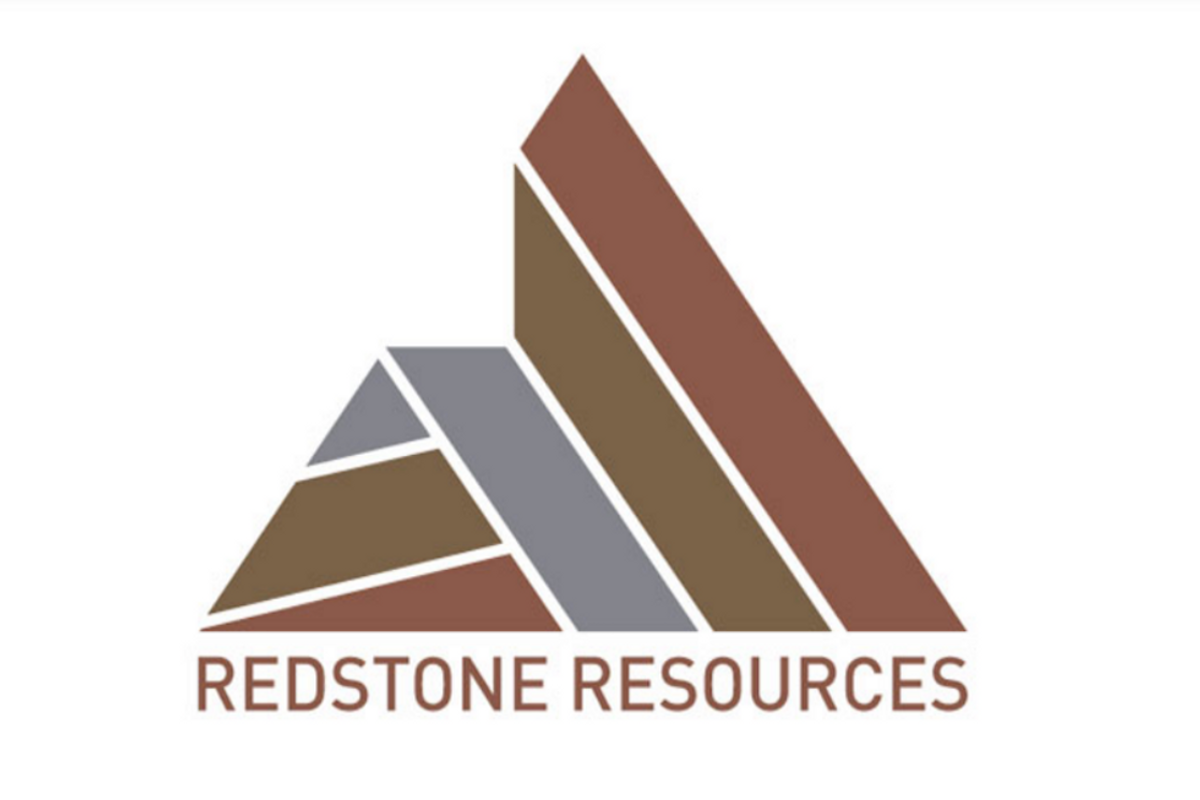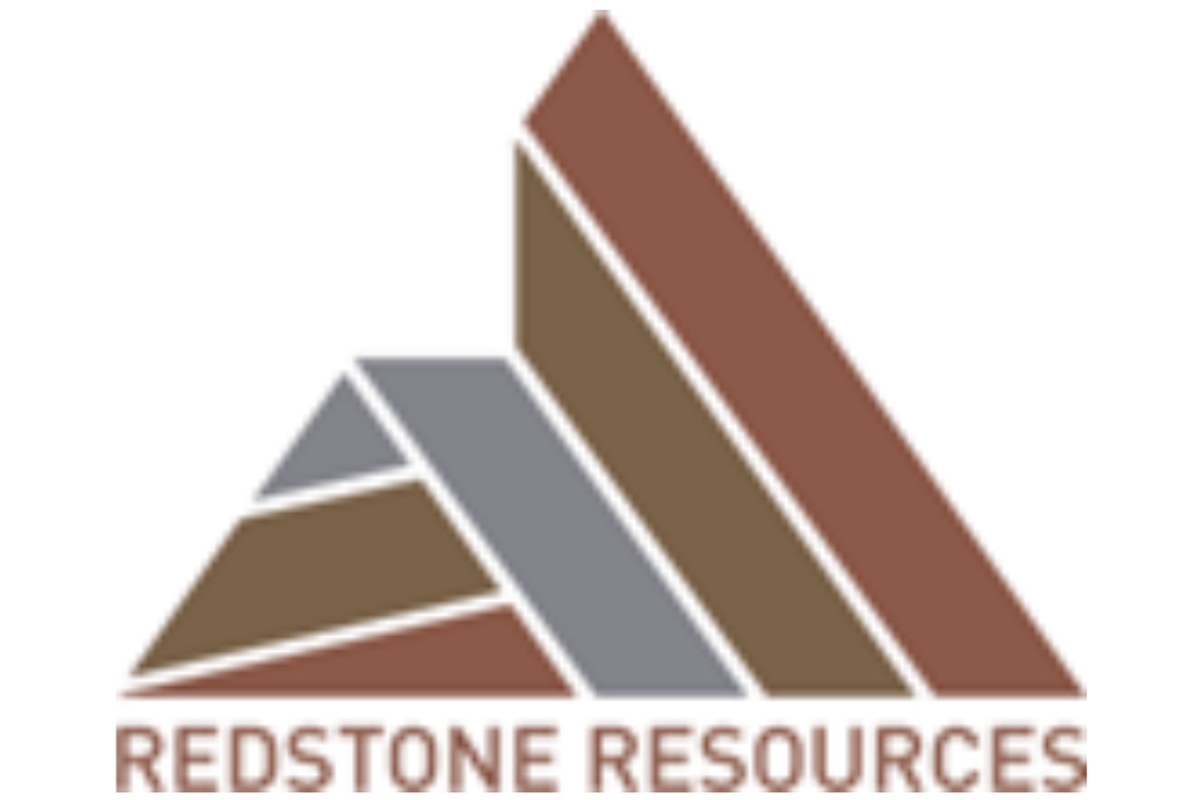
- WORLD EDITIONAustraliaNorth AmericaWorld
Investing News NetworkYour trusted source for investing success
November 20, 2022
Redstone Resources Limited (ASX: RDS) (Redstone or the Company) is pleased to announce that geochemical assays have confirmed the previously reported hh‐pXRF analyses (refer to ASX announcement of 23 November 2021) and show that the reverse circulation (RC) drilling completed at the end of 2021 has successfully proved that thick high‐grade lenses of copper mineralisation intersected in historical drilling at the Chatsworth Prospect (Chatsworth), Tollu, have significant volume vertically and extend to shallower depths. Chatsworth is part of the Tollu Copper Vein deposit on the Company’s 100% owned West Musgrave Project (the Project) in Western Australia.
HIGHLIGHTS
- Four (4) reverse circulation (RC) drill holes, TLC188, TLC189, TLC190 and TLC192, for a total of 756m were drilled at the end of 2021 at the Chatsworth Prospect (Chatsworth) at the Tollu Copper Vein deposit (Tollu) to test for continuity of volume between and beyond historical drilling.
- Geochemical assays have confirmed previously reported hand‐held portable XRF analyses that showed these drill holes intersected thick high grade copper mineralisation between and beyond the limits of the relative historical drilling; the significant intersections include:
- 10m at 2.51% Cu from 174m downhole (TLC188) including:
- 3m at 4.71% Cu from 175m downhole;
- 26m at 1.46% Cu from 61m downhole (TLC189) including:
- 1m at 5.1% Cu from 84m downhole;
- 16m at 2.88% Cu from 74m downhole (TLC190) including:
- 9m at 4.6% Cu from 76m downhole, which includes
- 2m at 7.62% Cu from 76m downhole;
- 22m at 1.26% Cu from 104m downhole (TLC190) including:
- 3m at 3.67% Cu from 122m downhole; and
- 25m at 1.10% Cu from 53m downhole (TLC192) including:
- 7m at 2.64% Cu from 60m downhole.
- 10m at 2.51% Cu from 174m downhole (TLC188) including:
- Drillholes TLC188 and TLC189 have extended the vertical continuity of the copper mineralisation in some of the historical drillholes to double that previous with at least some 100m of vertical extent and open at depth and towards the surface.
- The shallow extension of mineralisation by TLC192 extends the high grade mineralisation in this location to some 120m vertically and is open towards the surface.
- The success of the limited RC drilling at Chatsworth suggests that there may be opportunities in the Tollu resource1 yet to be realised.
- Assay results from the Company’s most recent drilling campaign completed in September 2022 remain pending.
- The Tollu Cu Vein deposit is 40km east of the Nebo‐Babel Ni‐Cu‐PGE deposit (Figure 1). The West Musgrave Project, which includes the Tollu Cu Vein deposit, has the ideal geological and structural setting for large magmatic Ni‐Cu sulphide deposits.
The West Musgrave Project, which includes the Tollu Cu Vein deposit, is located 40 kilometres east of the world‐class Nebo‐ Babel nickel‐copper‐PGE sulphide deposit now owned by OZ Minerals and has the ideal geological and structural setting for large magmatic Ni‐Cu sulphide deposits.
TOLLU COPPER VEIN DEPOSIT ‐ CHATSWORTH PROSPECT
At the end of 2021 four reverse circulation (RC) drill holes, TLC188, TLC189, TLC190 and TLC192, for a total of 756m were drilled at the Chatsworth Prospect, Tollu. The aim of the drilling was to test for continuity of mineralisation vertically through the hosting sub‐vertical vein system, and in doing so, test if the thick high grade copper mineralisation previously intersected in early drilling held volume between and beyond the historical drill holes, particularly at shallower depths than previously intersected.
Preliminary results of the drilling using hh‐pXRF analyses were announced in the ASX announcement of 23 November 2021. Geochemical assays have successfully confirmed these preliminary results, with generally higher Cu grades than the hh‐pXRF analyses but with slightly varying thicknesses.
As shown in Figure 2, drill holes TLC188 and TLC189, targeted approximately 15‐20m vertically above a high grade copper intersection in historical drill hole TLC033, drilled in 2010 and 25‐30m vertically below another high grade intersection in historical drill hole TLC034, also drilled in 2010 (refer ASX Announcement 21 February 2011 for further information on the historical drilling referenced). The historical drill holes suggest the mineralisation extends vertically between them but the vertical distance between the intersections is some 35m, a considerable distance for vein hosted mineralisation. The geochemical assays from TLC188 and TLC189 have confirmed that the thick high grade copper mineralisation continues vertically, being maintained in the deeper intersection with 10m at 2.51% Cu from 174m downhole, including 3m at 4.71% Cu from 175m downhole (in TLC188) and swelling in the shallower intersection with 26m at 1.46% copper from only 61m downhole, inclusive of 1m at 5.1% Cu from 67m downhole (in TLC189).
Click here for the full ASX Release
This article includes content from Redstone Resources Ltd, licensed for the purpose of publishing on Investing News Australia. This article does not constitute financial product advice. It is your responsibility to perform proper due diligence before acting upon any information provided here. Please refer to our full disclaimer here.

Sign up to get your FREE
Redstone Resources Investor Kit
and hear about exciting investment opportunities.
- Corporate info
- Insights
- Growth strategies
- Upcoming projects
GET YOUR FREE INVESTOR KIT
The Conversation (0)
14 May
Redstone Resources
Investor Insight
Redstone Resources is strategically positioned to benefit from rising global demand for battery metals, with 100 percent ownership of its copper-focused West Musgrave project in WA and a lithium acquisition in Canada.
Overview
Australia, a top global producer of key minerals like copper, nickel, lithium, and gold, supports growing demand through its stable, mining-friendly jurisdictions. The underexplored Musgrave Province hosts significant deposits of critical metals including nickel, PGEs, copper, and rare earths.
Redstone Resources (ASX:RDS) is exploring its 100 percent-owned West Musgrave Project in Western Australia, home to the Tollu Copper deposit. The project lies near major discoveries such as BHP’s Nebo-Babel and Succoth deposits, and Nico Resources’ Wingellina project.
With additional tenement applications in the region and a leadership team experienced in geology, exploration, and business development, Redstone is well-positioned to advance its battery and base metals strategy.
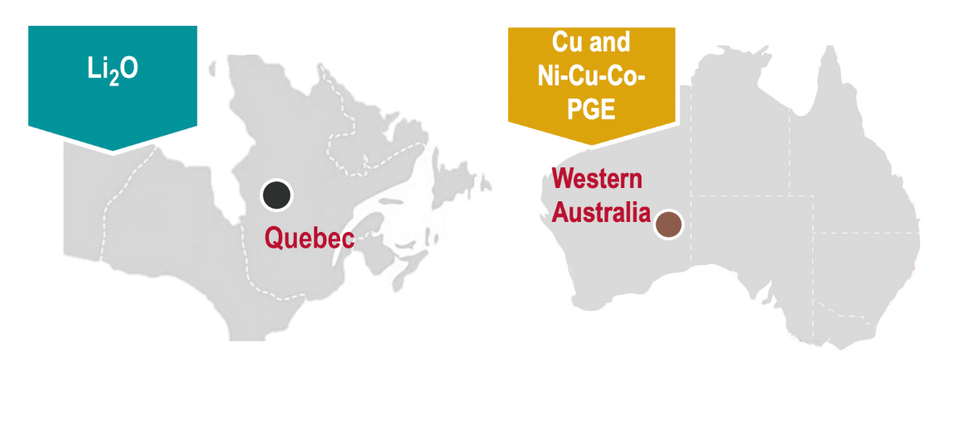
The unique Musgrave terrain has attracted major players like BHP, which is advancing construction of its Nebo-Babel nickel-copper-PGE mine after securing final approvals. The deposit hosts 390 Mt at 0.30 percent nickel and 0.33 percent copper, containing 1.2 Mt of nickel and 1.3 Mt of copper (2012 JORC). Alongside Nico Resources’ Wingellina nickel-cobalt deposit, these discoveries highlight the region’s potential as a major base metals hub.
Redstone’s West Musgrave Project lies between these key deposits—just 60 km east of Nebo-Babel and 50 km west-southwest of Wingellina. The project remains underexplored but is highly prospective, with geology suited to magmatic nickel-copper sulphides, VHMS, and large hydrothermal systems.
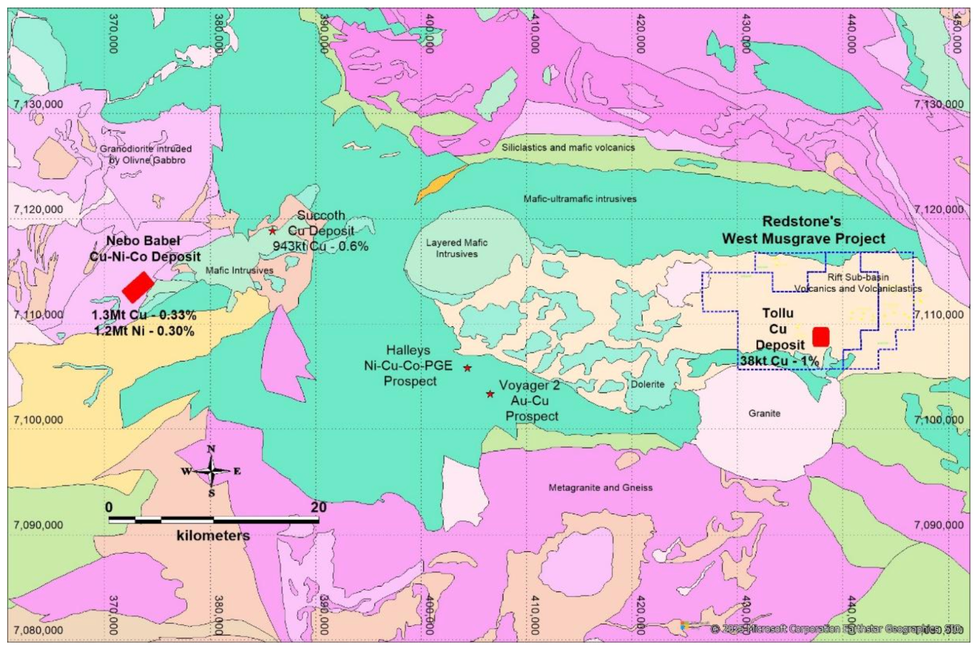
Location of Redstone's West Musgrave Project and the Tollu Cu Deposit relative to the world class Nebo-Babel Cu-Ni-Co Deposit and other deposits and prospects in the area.
Redstone Resources’ 100 percent-owned Tollu copper deposit, part of its West Musgrave Project, hosts a JORC-compliant resource of 3.8 Mt at 1 percent copper for 38,000 tonnes of contained copper (0.2 percent cut-off). A conceptual exploration target suggests potential for up to 627,000 tonnes of copper.
Expanding beyond Australia, Redstone is building a lithium portfolio in Canada through a 50/50 joint venture with Galan Lithium (ASX:GLN), acquiring 100 percent of the Camaro, Taiga, and Hellcat Projects in Quebec’s James Bay Lithium District. This region hosts key discoveries, including Patriot Metals’ (ASX:PMT,TSXV:PMET) Corvette Project and Winsome Resources’ ASX:WR1) Cancet Project. Notably, Patriot’s CV8 and CV13 pegmatites lie just 1.4 km from Taiga and 1.5 km from Camaro, respectively.
Redstone will manage the 5,187-hectare JV, backed by a seasoned team with deep expertise in exploration, operations, and corporate strategy.
Company Highlights
- Redstone Resources is an Australia-based mineral exploration company exploring highly prospective properties for copper and other base metals in the West Musgrave region of Western Australia.
- The West Musgrave region is home to major discoveries, including the world-class Nebo-Babel nickel-copper-PGE sulphide deposit and the Wingellina nickel-cobalt deposit, attracting significant interest from major miners.
- Redstone’s 100 percent-owned West Musgrave Project lies just 60 km west of BHP’s Nebo-Babel, highlighting the strong prospectivity of its tenure. The project hosts the Tollu Copper vein deposit, evidence of a large hydrothermal system, and is situated in a geological and structural setting highly favourable for magmatic nickel-copper sulphide, VHMS, and intrusive-related hydrothermal deposits
- Redstone Resources also has a 50/50 joint venture agreement with Galan Lithium, acquiring a 00 percent of a highly prospective suite of lithium projects in James Bay, Quebec.
- The Redstone and Galan Lithium joint venture project acquisitions complement the company’s West Musgrave and its strategy to increase exposure to the growing global battery metals and explore for critical minerals in high demand.
- A strong management team leads the company with decades of experience in the resources sector.
Key Projects
The West Musgrave Project
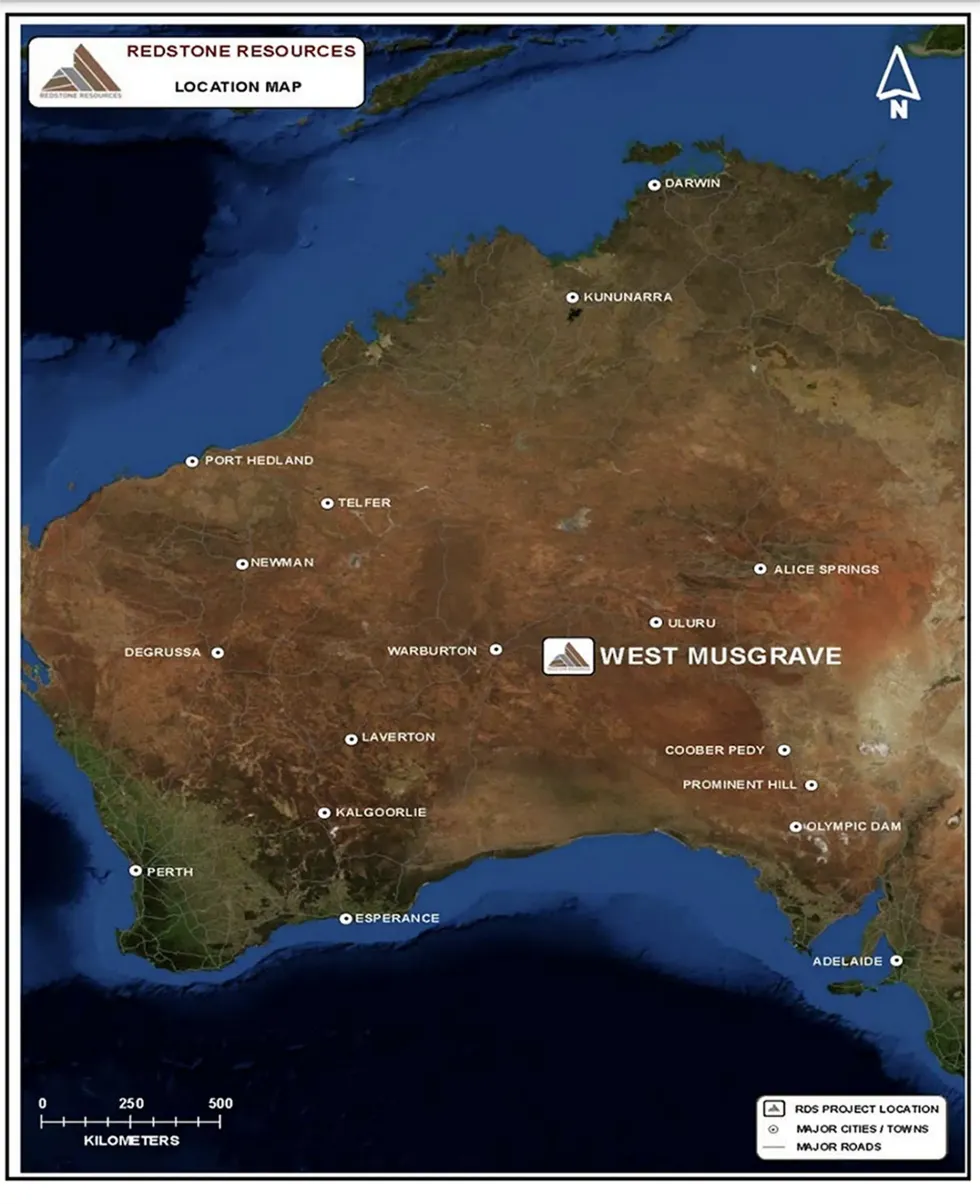
The West Musgrave Project spans 213 sq. km. of highly prospective yet underexplored terrain. Redstone believe their West Musgrave Project, and the entire West Musgrave Region, has the appropriate setting required to host major Ni-Cu-PGE deposits, such as the Voiseys Bay deposit in Canada. The geological setting of the West Musgrave is comparable to the Nain-Churchill province boundary in Canada, which in Labrador, hosts the world-class Voisey’s Bay deposit.
Voisey’s Bay is considered a ‘giant’ Ni-Cu deposit; in one section alone it contained 31.7Mt of ore grading 2.83 percent nickel and 1.68 percent copper. Voisey’s Bay is also relatively unique in that it is one of a very few Ni-Cu-Co deposits that are hosted in mafic, not ultramafic rocks. Another is Nebo Babel, which is situated only 60km west of Redstone’s Tollu Cu Deposit.
Drilling 7.5 km northeast of the Tollu Copper Vein deposit has confirmed the presence of similar rocks to those that host Nebo Babel, and with low-grade Cu mineralisation, further enhancing the prospectivity of Redstone’s project.
Given the favourable geology, Redstone believe it is possible that the high grade vein hosted Cu of Tollu could potentially be a remobilisation from a much larger accumulation of sulphides nearby and hence remains a priority target area for world class deposits.
The Tollu Copper Vein Project
Tollu, part of the broader West Musgrave Project, features a large swarm of copper-rich hydrothermal veins across a 5 km² area, with surface mineralisation linked to a dilation system between two major shears. The deposit hosts a JORC 2012 resource of 3.8 Mt at 1 percent copper and 0.01 percent cobalt, containing 38,000 tonnes of copper and 535 tonnes of cobalt, with strong potential for expansion through further drilling.
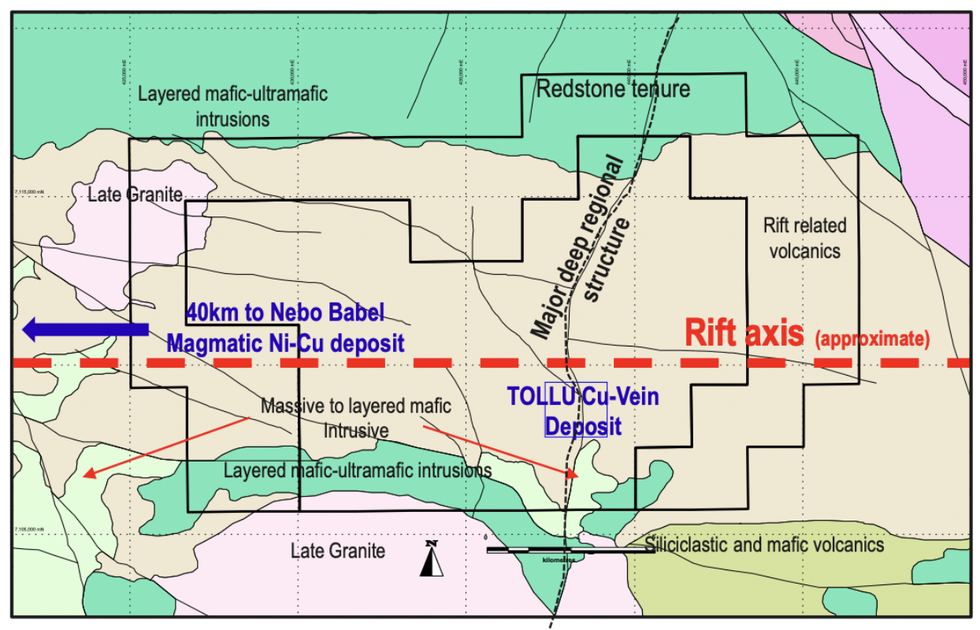
Local Geology Map – Redstone’s West Musgrave Project
The Tollu Cu deposit represents a high-grade Cu accumulation from the surface to a depth of approximately 400m as evidenced by deep drilling intersections that consistently deliver strong results, particularly at the Chatsworth and Forio prospects. These results include:
Chatsworth Prospect
- TLC189: 25m at 1.46 percent copper from 61m, incl. 1m at 5.1 percent copper
- TLC192: 25m at 1.1 percent copper from 53m, incl. 7m at 2.64 percent copper
- TC80: 10m at 3.4 percent copper from 427m, incl. 5m at 5.3 percent copper
- TLC033: 5m at 2.21 percent copper from 100m
- TLC034: 15m at 1.39 percent copper from 136m, incl. 3m at 3.67 percent copper
Forio Prospect
At Forio, drilling confirmed further high-grade zones, including the highest copper grade recorded to date at Tollu—1m at 18.5 percent copper from 18m in TLC203. Additional results include:
- 8m at 4.1 percent copper from 13m, incl. 1m at 18.5 percent copper (TLC203)
- 4m at 1.2 percent copper from 45m (TLC203)
- 6m at 1.47 percent copper from 80m (TLC201)
- 34m at 1.07 percent copper from 15m, incl. 2m at 3.2 percent copper (TLC181)
Redstone and Galan 50/50 Joint Venture
James Bay Lithium Projects - Taiga, Camaro and Hellcat
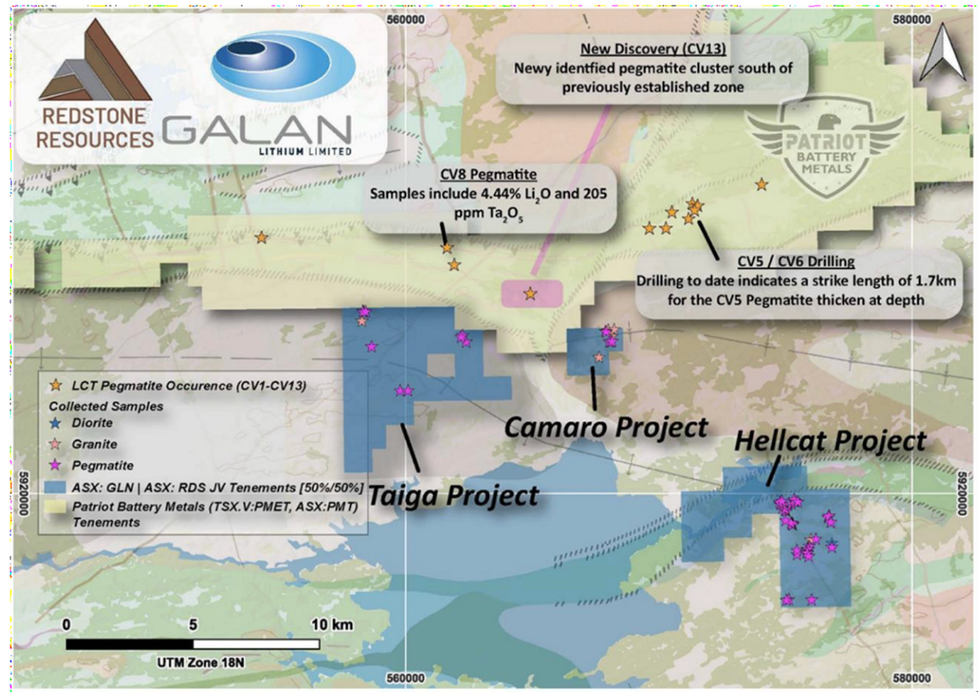
Redstone Resources and Galan Lithium formed a 50/50 JV to acquire the James Bay Lithium Projects in Quebec, comprising the highly prospective Taiga, Camaro, and Hellcat Projects. Covering 3,850 hectares, the projects lie adjacent to Patriot Battery Metals’ Corvette lithium discovery—just 1.4 km from Taiga (CV8 pegmatite) and 1.5 km from Camaro (CV13 pegmatite).
Project Highlights:
- Located in the La Grande Subprovince, with geology favourable for spodumene-bearing pegmatites.
- Hellcat sits on the Vieux Comptoir Granitic suite, believed to be the source of regional lithium mineralisation.
- Initial work by Axiom Exploration identified 28 prospective pegmatite dykes.
Previous initial exploration on the James Bay Lithium Projects completed by Axiom Exploration identified 28 prospective pegmatite dykes.
Board and Management
Richard Homsany - Non-executive Chairman
Richard Homsany is executive vice-president of Mega Uranium, a Toronto Stock Exchange listed company and executive chairman of Toro Energy Limited, an ASX-listed uranium company. He is also the non-executive chairman of Galan Lithium and the Health Insurance Fund of Australia Limited. Homsany was a corporate and commercial advisory partner with one of Australia’s leading law firms. He is currently the principal of Cardinals Lawyers and Consultants and has been admitted as a solicitor for over 20 years. He has extensive experience in corporate law, including advising public resources and energy companies on corporate governance, finance, capital raisings, takeovers, mergers, acquisitions, joint ventures and divestments.
Edward van Heemst - Non-executive Director
Edward van Heemst is a prominent Perth businessman with over 40 years of experience in managing a diverse range of activities with large private companies. He is the managing director of Vanguard Press and was previously the long-time chairman of Perth Racing (1997 to 2016). He was also appointed as non-executive chairman of NTM Gold, an ASX-listed company from July 2019 to March 2021. Van Heemst holds a bachelor of commerce degree from the University of Melbourne, an MBA from the University of Western Australia and is a member of the Institute of Chartered Accountants Australia.
Brett Hodgins - Technical Director
Brett Hodgins has over 20 years of professional experience in the resources sector primarily focused on exploration and mining operations. He began his career as a geologist with Robe River Mining and Rio Tinto Iron Ore. During that time he was involved with the commissioning and development of the West Angelas and Hope Downs operations. Hodgins' recent roles include general manager project development for Iron Ore Holdings and he is president/CEO of Central Iron Ore, a TSXV-listed company gold and iron ore explorer. He brings a wide range of experience in exploration, feasibility studies, operations, and has a broad knowledge of the resource sector.
Dr. Greg Shirtliff – Geological Consultant
Dr. Greg Shirtliff has over 20 years of experience in industry-related geology and geochemistry, including a PhD in mine-related geology from the Australian National University. Since his studies, Shirtliff has spent over 17 years in various roles in the mining and exploration industry ranging from environmental, mine geology, resource development, exploration and management roles, exploration and technical projects, inclusive of engineering and metallurgical. His roles have included several years at ERA-Rio Tinto’s Ranger Uranium Mine, as the senior geoscientist for Cameco Australasia and more recently as the lead geologist and technical manager for Toro Energy. Shirtliff’s exploration success at Toro Energy includes discovering multiple zones of massive nickel sulphide mineralization along the Dusty Komatiite, arguably the first massive nickel sulphide mineralization discovered in the Yandal Greenstone Belt in Western Australia.Keep reading...Show less
Exploring Australia’s copper-rich West Musgrave region and prolific lithium and battery metals areas in Canada
Latest News

Sign up to get your FREE
Redstone Resources Investor Kit
and hear about exciting investment opportunities.
- Corporate info
- Insights
- Growth strategies
- Upcoming projects
GET YOUR FREE INVESTOR KIT
Latest Press Releases
Related News
TOP STOCKS
American Battery4.030.24
Aion Therapeutic0.10-0.01
Cybin Corp2.140.00
